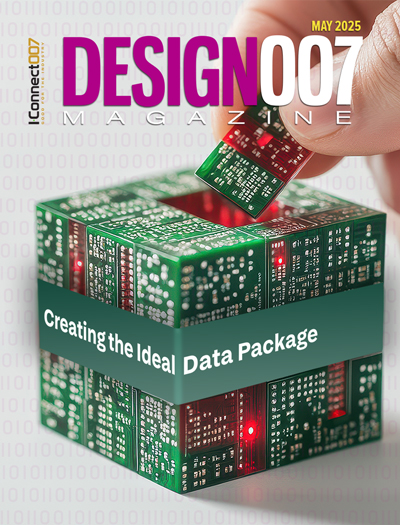-

- News
- Books
Featured Books
- design007 Magazine
Latest Issues
Current Issue
Creating the Ideal Data Package
Why is it so difficult to create the ideal data package? Many of these simple errors can be alleviated by paying attention to detail—and knowing what issues to look out for. So, this month, our experts weigh in on the best practices for creating the ideal design data package for your design.

Designing Through the Noise
Our experts discuss the constantly evolving world of RF design, including the many tradeoffs, material considerations, and design tips and techniques that designers and design engineers need to know to succeed in this high-frequency realm.

Learning to Speak ‘Fab’
Our expert contributors clear up many of the miscommunication problems between PCB designers and their fab and assembly stakeholders. As you will see, a little extra planning early in the design cycle can go a long way toward maintaining open lines of communication with the fab and assembly folks.
- Articles
- Columns
Search Console
- Links
- Media kit
||| MENU - design007 Magazine
True Experts Can Cite Their Sources
March 23, 2023 | I-Connect007 Editorial TeamEstimated reading time: 2 minutes
We’ve heard a lot lately about the need to identify tribal knowledge within our organizations. How do you know whether an “expert” is sharing documented knowledge or it’s just something they learned at their first job during the Carter administration?
We asked IPC design instructor Kris Moyer to explain his process for separating the wheat from the chaff, so to speak, in design knowledge. As he points out, a true expert will not be afraid to cite the sources and data sets behind their arguments. Ask questions; maybe there is a reason why they “always did it this way.”
Barry Matties: Kris, what are the signs when you think someone is presenting tribal knowledge?
When someone says to me, “This is the way I was told to do it,” I say “Why?” If their only answer is, “That's the way we've always done it,” I say, “Do some research and understand what the history was.”
It is always important to have a history of the rationale behind decisions that were made on the design so that we don't lose that knowledge. We may have done things a certain way at one point in history, but we must back everything up with rationale and quantified engineering data. That's the biggest problem with tribal knowledge: “This is how we've always done it. The company way is fine.” If you can answer why and have a technical rationale of why it's still valid, I'm all for it. Otherwise, I will push until you sit there and give me a technical rationale for why it's still necessary. Can you prove you’re right?
But when you're sitting in the classroom listening to a PCB design instructor, how do you validate whether that's just tribal knowledge? Do you accept that as the truth?
First, is the instructor a well-respected PCB design instructor? They should be current on their data and able to cite and show their data sources. The best teachers in the world love to be challenged. When a student says to me, “I came up with X, Y, and Z for that,” I'm always willing to look at their data, and see if it fits. If necessary, I’ll update my information.
Colleges and organizations love to be challenged on their data. You name it: IPC, IEEE, Johns Hopkins University Applied Physics Lab. Any organization that does engineering, data engineering, or research engineering white papers is usually more than happy to answer your questions.
To read this entire conversation, which appeared in the March 2023 issue of Design007 Magazine, click here.
Suggested Items
New Issue of Design007 Magazine: Are Your Data Packages Less Than Ideal?
05/09/2025 | I-Connect007 Editorial TeamWhy is it so difficult to create the ideal data package? Many of these simple errors can be alleviated by paying attention to detail—and knowing what issues to look out for. So, this month, our experts weigh in on the best practices for creating the ideal data package for your design.
RF PCB Design Tips and Tricks
05/08/2025 | Cherie Litson, EPTAC MIT CID/CID+There are many great books, videos, and information online about designing PCBs for RF circuits. A few of my favorite RF sources are Hans Rosenberg, Stephen Chavez, and Rick Hartley, but there are many more. These PCB design engineers have a very good perspective on what it takes to take an RF design from schematic concept to PCB layout.
Cadence Unveils Millennium M2000 Supercomputer with NVIDIA Blackwell Systems
05/08/2025 | Cadence Design SystemsAt its annual flagship user event, CadenceLIVE Silicon Valley 2025, Cadence announced a major expansion of its Cadence® Millennium™ Enterprise Platform with the introduction of the new Millennium M2000 Supercomputer featuring NVIDIA Blackwell systems, which delivers AI-accelerated simulation at unprecedented speed and scale across engineering and drug design workloads.
The Right Blend: Mixed Wireless Technologies
05/08/2025 | Kirsten Zima, Siemens EDAA common trend recently is to employ as many radios as possible on a single PCB. With the increase of wireless standards and the downscaling of PCB size, it can be difficult to know what the most critical design parameters are to focus on. In this article, we’ll discuss the most important considerations to make when designing with mixed wireless technologies, such as Bluetooth, GPS, and Wi-Fi, on a single PCB. These considerations include antennas, frequencies, FCC compliance, shielding, and layout with and without transition vias.
ZESTRON Announces New Reliability and Solutions Service for Risk Assessment & Mitigation of Electronic Assemblies
05/06/2025 | ZESTRONZESTRON, the leading global provider of high-precision cleaning products, services, and training solutions, is thrilled to introduce its new Reliability and Solutions (R&S) service.


